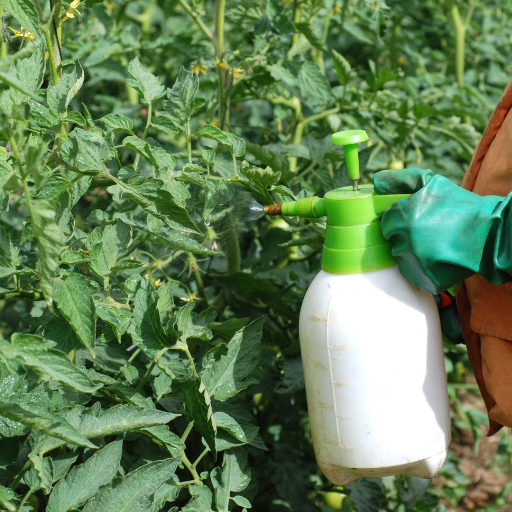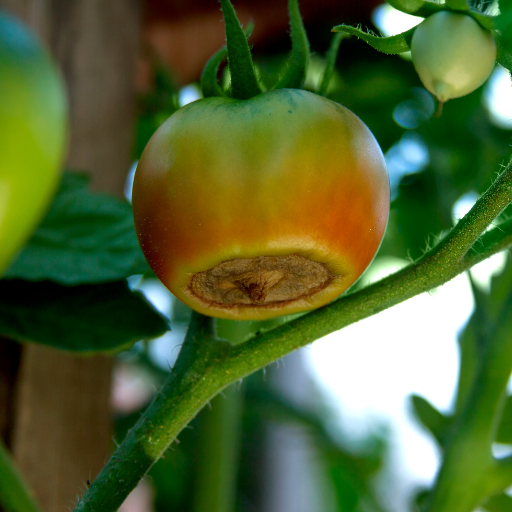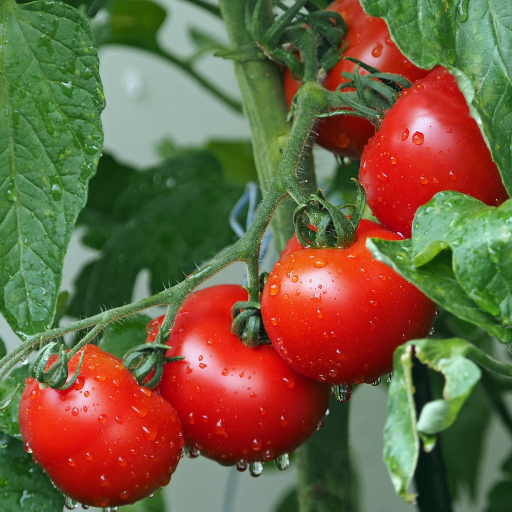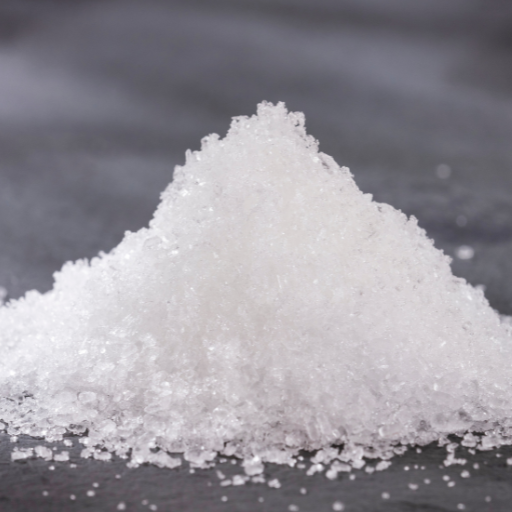Gardening enthusiasts always look for the most efficient and natural methods of developing the health and productivity of their plants. One such popular remedy in recent times is Epsom salts. This has been popularly known for its therapeutic uses among people but it also turns out to be an asset in the garden too . It can address specific nutrient deficiencies and boost growth vigor in tomato plants with correct application. In this article, we will examine how Epsom salts could enhance your tomato plants’ well-being by discussing its many advantages and offering practical tips on inclusion into gardening calendar. Experienced or not, if you understand why Epsom salts are good for tomatoes, then you can get a better yield from them.
How Does epsom salt Benefit Tomato Plants?
Epsom salts that is composed of magnesium sulfate aids tomatoes by addressing common nutritional deficiencies. Magnesium, the major atom in chlorophyll required for photosynthesis and energy production as well as green foliage formation. Sulfate ion is a vital constituent in amino acid synthesis that are proteins, which facilitate proper growth and development of a plant. Adding Epsom salt to your tomato plants will help address issues like yellowing leaves, slow growth or poor fruiting. This eventually provides healthy plants with lush leaves and tasty fruits at the end.
The Importance of Magnesium in Plants’ Health
Magnesium is an essential element in plants since it is found in chlorophyll, which takes part in photosynthesis process. Deficiency of magnesium hampers effective conversion of sunlight into energy hence poor growth and robustness. Moreover, magnesium activators many enzymes responsible for plant growth; also it supports DNA and RNA synthesis processes. Inadequate amounts of magnesium may result in yellowish leaves (chlorosis), stunted growth, underdeveloped fruits among others.Magnesium uptake by using products like epsom salt will ensure vigorous photosynthesis and health plant development.
Why tomatoes need Extra Nutrients
Tomatoes feed heavily thus demanding large quantities of nutrients to support their rapid vegetative growth including the flowering phase up to fruiting stage. As they develop, tomatoes take up key elements such as nitrogen, phosphorus, potassium and even magnesium from the soil around them. Nevertheless soils sometimes do not have these necessary minerals required for normal crop yield; hence some other forms should be considered so as to add these specific elements that would otherwise improve less productivity or affect general health of a given plant variety grown on particular soil type.Enhanced nutrient availability ensures thick healthy foliage potatoes that are strong rooted producing high quality decently tasting fruits; this kind of supplementary feeding discourages blossom rotting reduced fruit size inability by plants to grow taller while developing supporting successful harvest.
The Connection Between epsom salt and blossom end rot
Blossom-end rot (BER) is a common condition in tomatoes, characterized by a darkened, sunken area at the blossom end of the fruit. This is mainly due to lack of calcium in the developing fruit which may be complicated by irregular watering practices as well as fluctuations in soil moisture. Although Epsom salts can help with overall plant health since it provides magnesium, it does not address any lack of calcium directly. Nonetheless, maintaining balanced nutrition and providing enough magnesium from sources like Epsom salts supports efficient calcium uptake when present in the soil. Thus, though this alone cannot prevent BER taking place in tomatoes, it contributes towards a healthier background nutrient state that helps forestall onset of BER if sufficient calcium availability is maintained for the plants.
How to Apply Epsom Salt to Tomato Plants?

To put Epsom salt on tomato plants, dissolve 1 tablespoon of Epsom salt in a gallon of water. Use this mixture to water your tomato plants early in the growing season and then repeatedly apply this every two weeks.
In another way, you can spread Epsom salt directly into the soil during planting with approximately one tablespoon per foot of plant height. For existing plants, side-dress with the same amount midway through the growth season. Excess application should be avoided to prevent nutrient imbalances and possible damage of plants.
Methods for Adding Epsom Salt
Various methods exist for adding Epsom salt to tomato plants each having specific technical parameters that ensure optimal results. One such method involves soil application at planting time whereby you can add one tablespoon of Epsom salt per foot of plant height directly into the planting hole. Dissolve 1 tablespoon of Epsom salts in a gallon of water for foliar spray and spray it once after every two weeks on leaves of a single plant. Side-dress the existing plant with one tablespoonfuls over a period spanning up to four weeks or more depending on how fast it grows.
It is vital that these application rates and frequencies are maintained in order to avoid nutrient imbalances and any potential plant harm. The crucial point is that calcium levels in the soil must be adequate enough to support healthy fruit development because epsom salts alone don’t provide calcium but enhance overall nutrient uptake.
How much epsom salt should you use?
The quantity of epsom salts required by tomato plants depends on both method used and needs specific disease conditions may require more than normal amounts While planting off an inch-sized plant hole around its base, make sure one foot measures around one table-spoon fulls at most Tablespoonful doses for foliar sprays after eighteen days Side-dressing is done using about one tablespoon fulls during growing seasons per foot high.
Application rates and frequencies should be maintained to avoid nutrient imbalances and potential plant harm. Always ensure that there is enough calcium in the soil to assist fruits in maturing well. Epsom salt does not contain this but improves nutrient absorption.
When should epsom salts be applied?
To maximize its benefits, apply Epsom salts at specific times for tomato plants. Adding Epsom salt to the soil at planting time gives them a good start. Once plants start flowering and setting fruit, about every four to six weeks during the growing season, Side dress with Epsom salt. Every two weeks spray an Epsom solution on the leaves of plants containing magnesium and sulphur for foliar applications which are constant in quantity of each nutrients supplied. Nutrient imbalances are avoided by adjusting applications based on growth stage or need so as not to overdo things.
Can Epsom Salt Help with Blossom End Rot?

Calcium deficiency in tomato plants is the primary cause of blossom end rot, which results in dark, sunken spots on the fruit’s blossom end. Although Epsom salt is a form of magnesium sulfate and may help with magnesium deficiencies, it does not treat its fundamental cause which is lack of calcium. Sometimes Epsom salt can worsen the problem by adding more magnesium without providing enough or any calcium hence interfering with the plant’s ability to take up calcium. In order to control blossom end rot efficiently, it is necessary to incorporate supplementary supplies of lime or calcium nitrate into the soil through regular irrigation that would enable sufficient absorption of calcium.
What Is The Effect Of Epsom Salt On Calcium Uptake?
Magnesium rich Epsom salts can affect how tomatoes intake calcium. When too much magnesium builds up in plants due to excessive usage of Epsom salt, there will be competition with calcium for uptake at the roots level. This leads plants to absorb less calcium hence worsening problems such as blossom end rot caused by low levels of this mineral. Consequently, while implications for dietary magnesium insufficiencies show that it could be beneficial in some cases but balanced along with amendments rich in lime is essential so as not to disturb the delicate nutrient balance required for healthy development.
How Can Blossom End Rot be Prevented?
The most important practices are devoted to provision your tomato plants with a sufficient amount of moisture consistently and ensuring that they have enough amount of incoming calcium from other sources. Start by getting a soil test done together with an application of lime or gypsum if needed for increasing levels of this nutrient within the ground under cultivation where you grow tomatoes. Keep watering your crop regularly in order that it does not suffer from dryness and mulching aids water retention thereby reducing evaporative loss from soils below planting beds where these vegetables are cultivated and maintain their growth during hot months when irrigation water needs become greater because heat causes evaporation rates to rise. Do not overdo the fertilization, particularly using high nitrate levels as this might discourage the intake of calcium. Equally, it is necessary to avoid practicing any frequent plowing of land near your crop’s roots that could eventually lead to reduced uptake of nutrients due to damage in the process. By these means you can achieve more favorable conditions of cultivation and decrease blossom end rot threat.
Symptoms of Magnesium Deficiency in Tomato Plants
Different symptoms are manifested when tomato plants experience a lack of magnesium. One common sign is yellowing leaves especially toward older leaves while veins remain green hence creating distinctive interveinal chlorosis pattern. This coloration usually starts from leaf margins going towards inside. Between the veins severe cases may have areas that turn necrotic and brown resulting into early defoliation. Another indication is stunted growth and reduced vigor in magnesium deficient plants which negatively affect fruit yield and quality too. Therefore, such symptoms should be monitored for their uprightness by supplying sufficient amounts of magnesium salts such as Epsom Salt, which will allow healthy plants with highest possible yields to grow.
How to Identify Magnesium Deficiency in Tomatoes?

To identify magnesium deficiency in tomatoes, you should look for specific symptoms such as yellowing between the veins of the leaves (interveinal chlorosis), while the veins remain green. It starts on old leaves first. Leaf curling and possible brown necrotic spots may also occur around the edges of affected leaves (Arnold et al., 2015). Severe cases may result in leaf drop before time. By examining plants and testing soil at regular intervals, it will be easier to know if there is such a problem and when to intervene.
Yellow Leaves as a Sign of Other Problems
Tomato plants with yellow leaves can indicate several problems like nitrogen deficiency, diseases, overwatering or underwatering. Usually, nitrogen deficiency makes older leaves become uniformly yellow while new ones will be green. Over-watered plants have poor oxygen flow to the roots that causes root rotting which turns the leaves yellowish and reduced nutrient uptake rates. Under watering will make leaf blades turn yellowish before eventually wilting because water cannot get to some parts of the plant. Yellowish leaves are also caused by diseases like Fusarium wilt and Verticillium wilt accompanied by wilting and stunted growth. Soil testing can help in maintaining appropriate level of nitrogen; water management system that aims at achieving consistent soil moisture content; continuous monitoring for disease symptoms.
Soil Test for Confirming Deficiency
There are some steps involved in performing a soil test to confirm nutrient deficiencies so that you can get reliable results . The first thing is collecting samples from different parts of a garden usually about six inches deep using clean tools so as not to mix up contaminants with your sample material. Then put them together into one container that already has been cleaned up ready for air drying process (Olsen, 1996). Then send it dried or use kits sold online for home use approved by reliable companies who can proceed to analyze it. The test will help to determine pH, nitrogen (N), phosphorus (P), potassium (K) and magnesium (Mg). The optimum pH range for tomato growing is from 6.0- 6.8 while levels of nitrogen should be anywhere between 40 to 60 ppm, phosphorus levels of about 10 to 15 ppm, and potassium readings of between100 -200ppm. Magnesium levels should be between the ranges of 50 – 120 ppm. Adjusting soil nutrient composition according to the results can help maintain suitable nutritional balance for good crop production.
How Applying Magnesium Sulfate Affects Plant Health
Magnesium sulfate or Epsom salt is a common remedy applied in many cases where magnesium and sulfur are in short supply in plants. It is responsible for the production of chlorophyll that photosynthesizing cells use (Fiscus et al., 2013). When it is lacking, interveinal chlorosis sets in, causing leaves to change color but not veins, thus affecting the plant’s effective photosynthesis ability. Elemental sulphur is needed to make certain amino acids and proteins.
On top of improving magnesium absorption rates, adding magnesium sulfate also enhances uptake of other micronutrients particularly phosphorous as well as nitrogen which are essential components for growth processes in plants like tomatoes. It can be dissolved into water and used as foliar spray or mixed with soil during application on crops though various ways; it may also be sprayed directly onto leaves at a rate about one tablespoon per gallon every fortnight during most vegetative stages or incorporated into soil at about one/two tablespoons per plant throughout growing period (Bonaccorso et al., 2012). Regular application ensures healthy green leaves hence preventing physiological issues such as blossom end rot due to proper maintenance of balanced Mg levels in tomatoes.
What Are the Common Mistakes When Using Epsom Salt on Tomato Plants?

One typical error is overuse, which may result in salt accumulation in the soil leading to nutrient imbalances and potential root damage. Another typical mistake is applying Epsom salt for reasons that have nothing to do with magnesium or sulfur deficiencies like misdirected irrigation or other deficiencies in nutrients. Lastly, many gardeners fail to test their soil first before adding Epsom salts. This can lead to unnecessary or harmful supplements if the soil already contains enough magnesium. These mistakes only hinder the plant’s health rather than improving it.
Excessive Use: How Much epsom salt is Too Much?
Too much application of Epsom salt can be harmful to your tomato plants. It is necessary to follow recommended dosages for best results. Oversupplying of Epsom salts can cause a build-up of magnesium in the soil interfering with uptake of other essential nutrients like calcium and potassium, leading to imbalances that may harm growth of the plant.Therefore, generally, one should not use more than 1 tablespoon per foot height per plant every six weeks; while at the same time it is advisable to carry out regular soil tests so as not to overdo on supplementation.
Potential Soil pH Imbalances
The utilization of epsom salt on tomato plants might affect soil pH levels in them. However, even though it does not radically change soil pH levels itself, its overdose can gradually produce slight shifts that would impact availability of nutrients. A balanced soil pH (6-7) is crucial for optimal nutrient uptake by tomato plants. Here are technical parameters:
- Soil pH Testing: Conduct regular soil tests for monitoring pH levels and ensure they are within the right range for tomatoes available at most garden centers or extension services are reliable kits for testing soils.
- Magnesium Levels: Normal soils contain about 25-50 ppm (parts per million) magnesium per volume. The overapplication of epsom salts increases these levels outside the optimum range, affecting the balance between calcium and potassium.
- Calcium and Potassium Ratios: Magnesium should be 10-30% of the soil’s Cation Exchange Capacity (CEC). When in excess, it interferes with calcium and potassium uptake, which are important nutrients needed for fruit development and overall plant health.
Maintaining these parameters ensures that Epsom salt benefits tomato plants without causing harmful imbalances in soil chemistry.
Using epsom salt with Other fertilizers
The combination of Epsom salt with other fertilizers should be done carefully to ensure compatibility of nutrient uptake as well as prevent any negative effects. It can blend well with balanced fertilizers that contain major macronutrients such as nitrogen, phosphorous, and potassium. For instance, mixing complete N-P-K fertilizer with Epsom salts will provide a more comprehensive nutrient profile addressing both macro and micro-nutrient needs. However, over-fertilization should be avoided; therefore always follow manufacturer’s instructions while considering existing soil nutrient levels. Moreover, adding organic matter like compost to the garden bed will help improve soil structure for better root growth and allow for greater nutrient absorption by plants hence aiding their productivity.
Using Epsom Salt in the Garden for Other Plants

There are other plants apart from tomatoes that Epsom salt is good for. This will enhance color and improve the uptake of nutrients leading to more abundant blooms in roses. If this is mixed with one tablespoonful of Epsom salt per gallon of water and provided to the soil around each rose bush, it can produce noticeable improvements. Epsom salt can also stimulate grass growth as well as greening lawns naturally. Three pounds of Epsom salt should be used for every 1,250 square feet of lawn as a general guideline. Additionally, peppers and other flowering plants like magnesia carbonica, need Epsom salt so that it can improve blossom production and fruit yield. For instance, mix one tablespoon with a gallon of water and spray directly into the foliage every two weeks.
Do Other Vegetables Benefit from Epsom Salt?
Yes, it does because Epsom salt is rich in magnesium and sulfur which are vital mineral elements required for plant development. Thus eating foods grown using such fertilizers brings about improved yields plus healthier crops (peppers). However if not applied correctly, over application can cause nutrient imbalances hence care must be taken when using them As a soil drench or foliar spray, apply 1 table spoon per gallon of water every two to four weeks for optimum results. Always think about ground samples so as to change the right rates according to your personal garden.
How Does Epsom Salt Help Plants Like Peppers?
This essential magnesium is supplied by Epsom salts which are very important components especially chlorophyll that assists in photosynthesis allowing the plant to capture light energy effectively . There may be yellowing leaves due to lack of magnesium in pepper plants and stunted growth may occur again . Peppers’ flavor is enhanced by sulfur within this component (Epsom salts) Building lush bushes with many blossoms resulting into high yields vibrant peppers; these are some of the results that regular Epsom salts applications may give. For optimal results, recommended guidelines should be adhered to while applying it as a foliar spray or soil drench.
What Is the Recommended Dosage of Epsom Salt for Different Plants?
The amount of Epsom salt that is required for different plants differs widely. Two tablespoons per gallon of water and use as a foliar spray fortnightly is recommended also in roses. Burying two tablespoons in each hole when planting tomatoes and monthly application by dissolving one tablespoon in each gallon of water can yield better results than before. Houseplants require two table spoons dissolved in one gallon of water every four to six weeks too. Maintaining lush green lawn requires spreading three pounds of Epsom salt over 1250 square foot area using spreader twice annually at most times. Finally, always have the soil tested before using to adjust for specific garden needs.
Reference sources
- National Garden Bureau – Epsom Salts for Tomatoes? An Expert Weighs In
- Summary: This source discusses the benefits of using Epsom salts for tomato plants, particularly in soils with a pH of 6.5 or higher. It provides guidance on diluting Epsom salt at a specific rate per gallon of water to support healthy plant growth.
- Epic Gardening – Is Epsom Salt Good or Bad For Tomato Plants?
- Summary: This article addresses the effectiveness of Epsom salts for tomato plants, highlighting their positive impact when tomatoes are facing magnesium deficiencies. It offers insights into the role of Epsom salts in enhancing tomato health under certain conditions.
- GrowVeg – Fix Yellow Leaves on Tomato Plants Using Epsom Salts
- Summary: Focused on practical solutions, this source explains how Epsom salts, rich in magnesium sulfate, can be used to address yellowing leaves in tomato plants due to magnesium deficiency. It provides actionable advice on applying Epsom salts to improve plant health.
Frequently Asked Questions (FAQs)
Q: How does Epsom salt benefit tomato plants?
A: Epsom salt contains magnesium, which is critical for seed germination and helps strengthen cell walls, aiding in the overall health of tomato plants. Using Epsom salt for tomatoes can result in healthier and more abundant yields.
Q: How should I apply Epsom salt to my tomato plants?
A: Dilute Epsom salts in water and use a spray bottle to apply directly to the leaves or mix it into the soil. This ensures even distribution and absorption by the plants.
Q: When should I start using Epsom salt for my tomato plants?
A: Start using Epsom salt during seed germination and continue to apply it every two weeks throughout the growing season. This helps support the plants from the seedling stage through to mature, fruit-bearing plants.
Q: Can I add Epsom salt to the hole when planting tomatoes?
A: Yes, adding a cup of Epsom salts to the planting hole can give young plants an early boost of magnesium, which is beneficial for healthy growth.
Q: How much Epsom salt should I use for my vegetable garden?
A: Typically, one to two tablespoons of Epsom salts per gallon of water is sufficient. This mixture can be used to water or spray the plants every two weeks to supplement their magnesium needs.
Q: Are Epsom salts good for other vegetables besides tomatoes?
A: Yes, Epsom salts are good for a variety of vegetables, including peppers. Magnesium is essential for many plants, helping them grow better and produce more fruit.
Q: Can using Epsom salt improve seed starting?
A: Indeed, Epsom salt can improve seed starting by providing magnesium, which is critical for seed germination. It can be particularly effective in helping seeds sprout and develop into healthy seedlings.
Q: Is there a risk of adding too much Epsom salt to my plants?
A: Yes, adding too much Epsom salt can harm your plants. It’s important to stick to recommended amounts, typically one to two tablespoons per gallon of water, to avoid overloading your plants with magnesium.
Q: How can I tell if my tomato plants need more magnesium?
A: If your tomato plants look yellow between the veins of their older leaves or you notice lower yields, it might indicate magnesium deficiency. Using Epsom salt for tomatoes can help address this issue.
Q: Should I use Epsom salt on newly germinated seedlings?
A: Yes, you should use Epsom salt on newly germinated seedlings to ensure they have enough magnesium for strong initial growth. This can be done by adding diluted Epsom salts in water to their watering schedule every two weeks.






